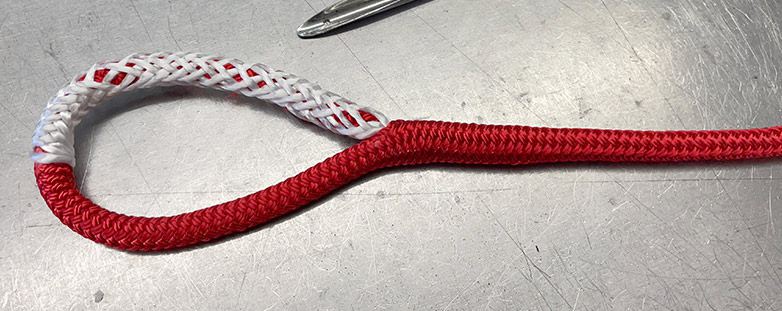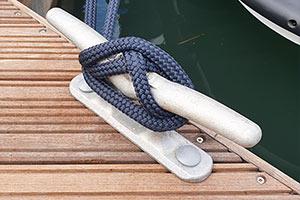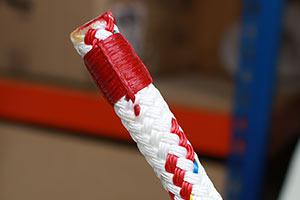10 Good Reasons to get your Ropes Spliced
The Importance of Splicing your Ropes

The Jimmy Green Rigging Team are frequently asked questions about splicing and why it is important:
What is Rope Splicing?
A yacht rope splice is a tried and trusted method for joining two ropes or creating a loop at the end of a rope to connect to a piece of hardware by interweaving the strands, thereby avoiding the need to tie a knot.
The Most Popular Types of Rope Splices and their Uses
● Loop Splice – creating a simple loop by turning the end around and interlacing the individual strands back along and into the rope – for attaching directly to a cleat.

● Eye Splice – turning the rope tightly around a hard thimble and interlacing the individual strands back along and into the rope – for attaching to a shackle or similar deck hardware.

● Back Splice – forming the end into a crown and interlacing the individual strands back along and into the rope – to prevent the rope end from fraying.

● Rope to Rope Splice - joining two ropes by interlacing the individual strands of one end into the strands of the other end – to join two rope ends e.g. into an endless loop.

● Rope to Chain Splice – joining a rope to a length of chain by turning the rope tightly around the end link and interlacing the individual strands back along and into the rope or by interconnecting the individual strands in and out of the links along the chain – to form a strong windlass gypsy friendly connection between a rope and an anchor chain.

Rope Splicing Methods
The splicing process varies according to the rope construction and the fibre content. Modern yachting ropes are manufactured in all sorts of different configurations. Technological advances have moved rope design forward from the traditional three-strand twisted lay format to eight strands in a square design. Braiding and Plaiting have also advanced in recent years, modifying the number of outer plaits, with and without an inner core. As new, more advanced ropes become available, a new splicing technique is required to match.

What are the Alternatives to Rope Splicing?
This list is not exhaustive, but it should cover the main methods:
Tying a knot
The Advantages of Tying a Knot
- If you know your knots, they are quick to produce, even under pressure.
- Knots and hitches are a good stopgap solution.
The Disadvantages of Tying a Knot
- Knots are bulky, making them awkward and cumbersome to handle, especially when passing the end through a tight space.
- Knots may be considered unsightly or unseemly onboard a ‘tight ship’.
- Knots can slip or come undone accidentally, which may prove problematic or potentially disastrous.
- Knots, even those tied correctly, cause a major loss of strength in the rope, whereas a skilfully executed splice can be nearly as strong as the rope.
- Knots which involve one rope passing across the other at right angles can reduce the breaking load of the rope by up to 50%
- The knock-on effect is that you may need a larger diameter rope to achieve the desired strength leading to extra cost.

The arrow points to the most likely fail point in a bowline with two parts of the line locked opposing one another.
Making the rope off on a cleat
Taking turns around a deck cleat or a similar strongpoint, following a figure of eight pattern is known as ‘making off’. This solution is reasonably quick, adjustable, and perfectly acceptable if executed proficiently. Even several hurried wraps may suffice as a temporary measure. However, a bollard will need to be made off differently because the figure of eight wraps won’t work without the T or cross shape of a deck cleat.

Passing the end through a jammer or clutch
Jammers (also known as jamming cleats) and Clutches provide the means to hold, pull in or release a rope, making them more conveniently adjustable than an ordinary cleat. Jammers can have open jaws, allowing rapid redistribution. Clutches and some jamming cleats are captive, requiring the line to be reeved through, making them a more permanent arrangement.

Stitching and Whipping
Stitching and whipping the end of a rope is the best alternative to a splice because it binds all the strands together and prevents the end from fraying. A stitched and whipped end is advisable when using any of the methods previously mentioned (knots, cleats, jammers, and clutches).

The Advantages of Yacht Rope Splicing
Durability and Security
Splicing creates a smooth, snag-free, tapered connection, reducing the chances of undue wear and tear and extending the working life of the rope.
Splicing is far more dependable than a knot, making it preferable for mooring, anchoring, and rigging applications. Stitching and whipping the splice is good practice to make it unshakeably reliable in all weathers.
Strength
A splice will be far stronger than any knot. Depending on the type of rope, a proficiently executed and finished splice will achieve between 85% and 100% of the manufacturer-rated breaking load.
If you rely on knots, you may need to increase the diameter of your ropes to achieve your desired working load, making them less easy to handle and potentially much more expensive. There may also be a knock-on cost effect for all your fittings, e.g. winches, blocks, fairleads and clutches, because you may need to upgrade them to accept the larger rope.
Handling and Management
Spliced ropes are more manageable and easier to attach and disengage. In addition, they improve efficiency because they are ergonomically user-friendly. Your crew, especially those relatively unpractised in the art of sailing, will appreciate finding their assignments during onboard manoeuvres much easier to achieve. Their sailing will undoubtedly be more enjoyable as a result.
A Splice is the best way to attach a rope because it avoids tying a knot.
Aesthetics and Yacht Appeal
An accomplished, spliced and whipped finish to all the ropes onboard will give you a justifiable sense of pride and satisfaction in a job well done.
Splicing is an art form requiring unique skills and techniques that can’t be mechanised.
Smart spliced lines attract admiration from other yacht skippers and crew, whether they are mooring warps, anchor warps, sheets, halyards, control lines, or simply your fender lanyards.
Spliced lines are neat and tidy, promoting a positive attitude to safety and efficiency.

So, what reasons (or excuses) are there not to splice your ropes?
Finishing the ends of a rope with a stitch and whip may be preferable, which is quite appropriate for some applications.
The other reasons come down to time, confidence, and cost.
There are different splices for every conceivable type of rope, and you may not have the time or inclination to learn them all. Also, practice makes perfect, and you may not want to waste copious amounts of rope trying to perfect each method. Each one requires a meticulous methodology to achieve a secure, dependable result. This may explain why knots are so appealing.
The process can also be physically demanding, requiring a firm grip, dexterity, and tough fingers. Lengthy practice sessions are undoubtedly the best approach for attaining the necessary cohesion, uniformity, and strength, but tackling a raft of splices in one stint may result in painful hands and sore fingers.
Confidence in your splicing ability is a must to ensure the more technically difficult splices have the necessary strength and durability, especially for critical applications. On the other hand, you may decide that discretion is the better part of valour and stick to what you know, leaving the job to a professional rigger.
The last thing you need is a bodged splice which may prove unreliable when the chips are down.
Cost is an undeniable factor, but it may be prudent to budget for the professional finish in key areas if the complete set is unaffordable.
Ten Top Reasons for Choosing a Splice to Attach your Ropes Onboard
- Optimum strength
- Superior security
- Permanent solution
- Excellent Durability
- Easier Handling
- Increased efficiency
- Ultimate load-bearing capability (hard eyes)
- Higher abrasion resistance
- A justifiable feeling of pride in a job well done
- The Jimmy Green Rigging Team will apply the Professional Finish for you














